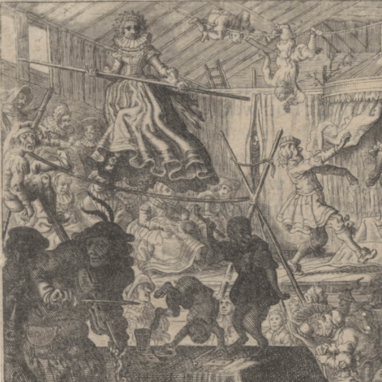
Circus Shows Up Everywhere
Finding women in circus while looking for lost early modern drama: Circus shows up everywhere.
November 2024, I attended State Library of Victoria’s Foxcroft Lecture series, which featured Professor of Shakespeare and Early Modern Drama at the University of Melbourne David McInnis.
I am fascinated with the archive and how are the works are determined to be significant or relevant, how are they saved, whose voices are preserved and whose are lost to time.
I was expecting to learn about works like Love’s Labour’s Won - and I did, the lecture was fascinating. Favourite new fact: from 1567-1642 only 543 plays from the London commercial theatres have survived and as many as 744 plays identifiably lost. Can you imagine not just the works that are lost but the ones we don’t even know existed!
But a good question I found myself asking, when considering the history of circus, is how much of it have we lost because we simply didn’t know it existed? Most of our historical information of western theatre is understood because of the convention of the written script. But for an art form without a significant written tradition, we rely on the stories that were told of it. Seems to be a historical privilege to be written and preserved in an archive.
During the end of the lecture, a question was raised: how many of these lost works in early modern drama were by women. The answer was of course predictable: not many. It was not unheard of entirely for a woman to work in theatre – some wrote plays or were shareholders but not significant numbers and certainly not as theatrical performers, when at the time, female roles were played by young male actors.
There was however one statement that stood out to me: there were women involved in SOME aspects of performance. Not acting, but rope-dancing.
Rope-dancing? McManus & Munro wrote “Using an easily assembled kit of ropes and poles, rope-dancers leapt, walked, and ran on the tight rope; they spun around the slack rope, hung from it by their legs or feet, or lounged on it in a display of impossible leisure; they ran up or ‘flew’ down sharply angled ropes on the diagonal”
Slack rope and tight rope! Say what! Circus acts, in 1600’s England, by women?!
McInnis pointed anyone interested to the work “Engendering the Stage in the Age of Shakespeare and Beyond”, a Practice in Research project analysing the performance of gender in early modern drama.
The article “Women’s Investment and Performance at the Fortune Playhouse” touched on Cecily (or Sisley) Peadle, a rope-dancer and tumbler, and one-time head of a touring company! Records show the troupe under her leadership were permitted to “exercise dancing on the ropes, tumbling, mauling and other such like feats which they or any of them are practised in or can perform”.
This was in 1630! Juliet is still played by teenaged boys, and Phillip Astley hasn’t even invented the modern circus, and yet there’s a tumbling, rope-dancing troupe at a theatre in England, led by a woman!
Continuing down the circus history rabbit hole: McManus writes an article that contrasts the boy-actresses of Shakespearean stages, to the “muscular enactment of femininity by women performing ‘feats of activity’, the display of the extraordinarily skilled body” on the ropes.
The article has a few sketches of the act - all women, performing on ropes that are slack or tight, for swinging under or dancing across, for feats of strength and grace alike, the rope becoming a performance stage where women weren’t just included, but highlighted.
We often think of history as something static, set, finished, but much of our work today is reconciling what exists within the archive, with what has actively or accidentally excluded. The more we learn - while keeping an open mind to what else could be out there - the more we expand the picture and our understanding of what has come before us.
Sure, the number of facts I know about the life of Cecily Peadle, I can count on one hand. But what is important is that I know she did exist. And other women, like Cecily, played similar roles in theatre at the time. There’s even a link between circus and early modern drama!
So many connections made, unexpectedly, when I was just expecting to learn a little Love’s Labour’s Won.
- written by Natalie Frijia